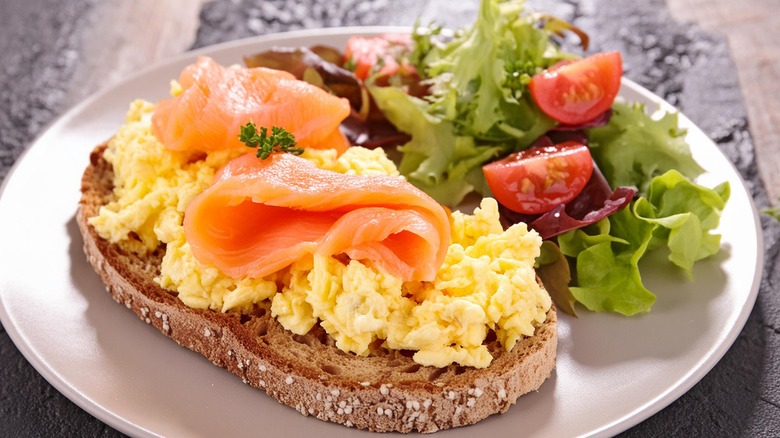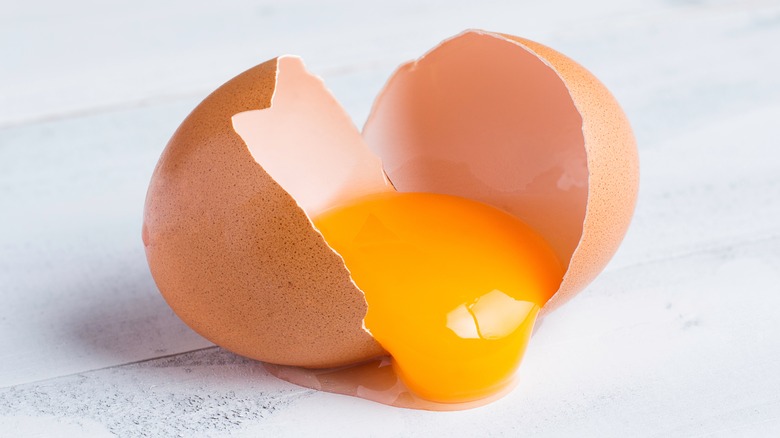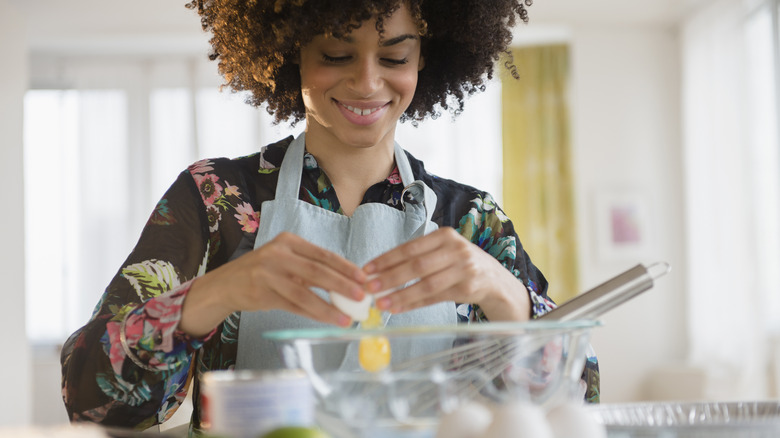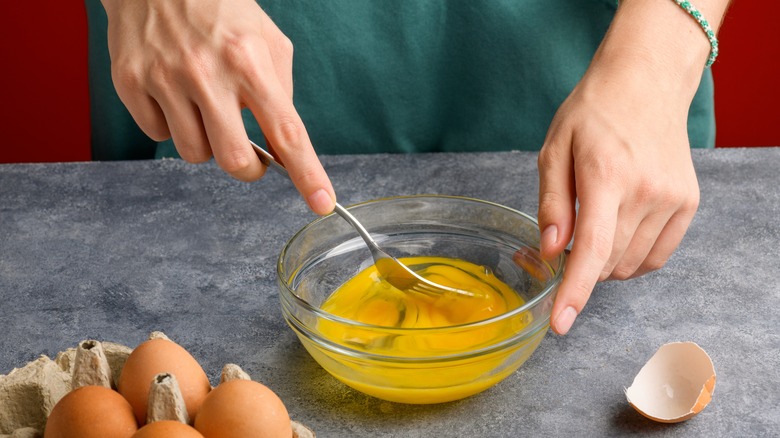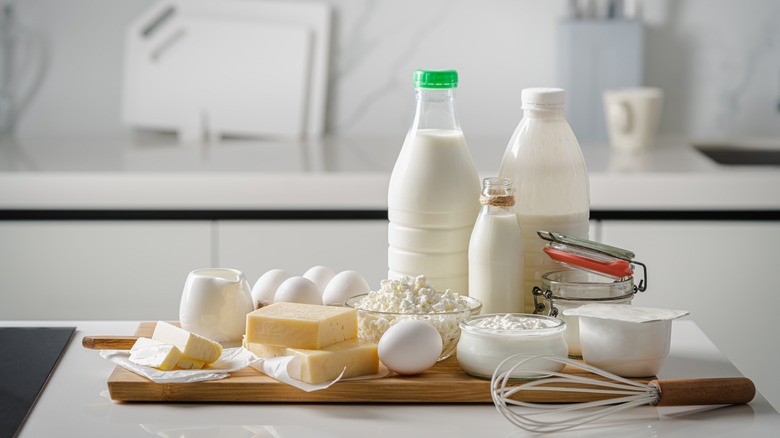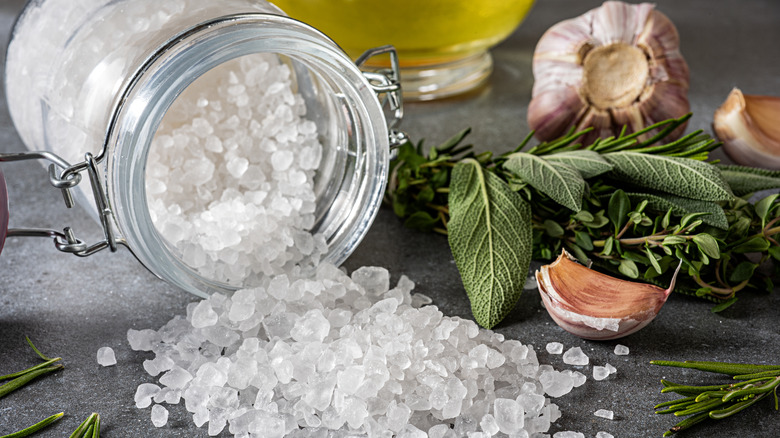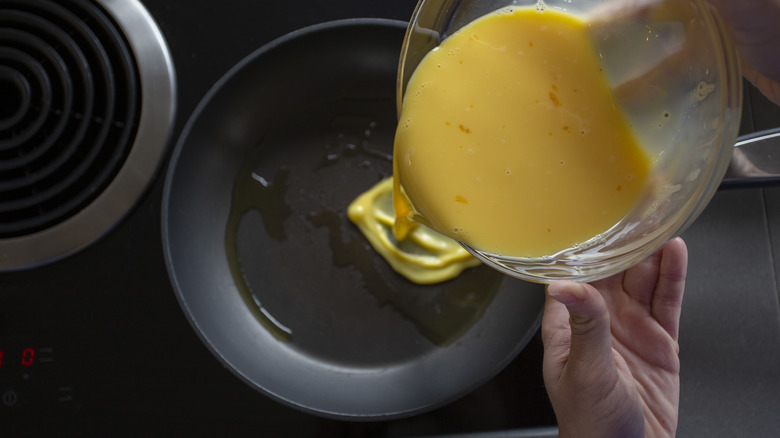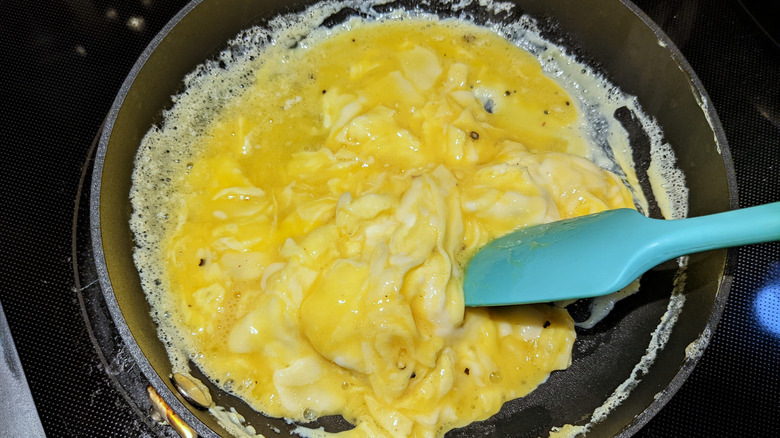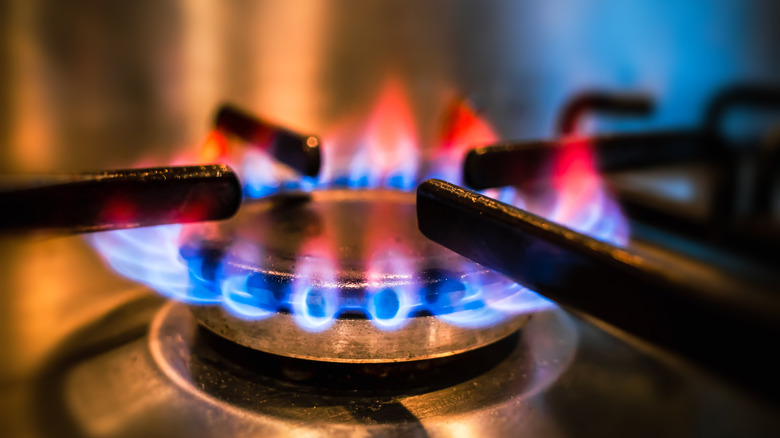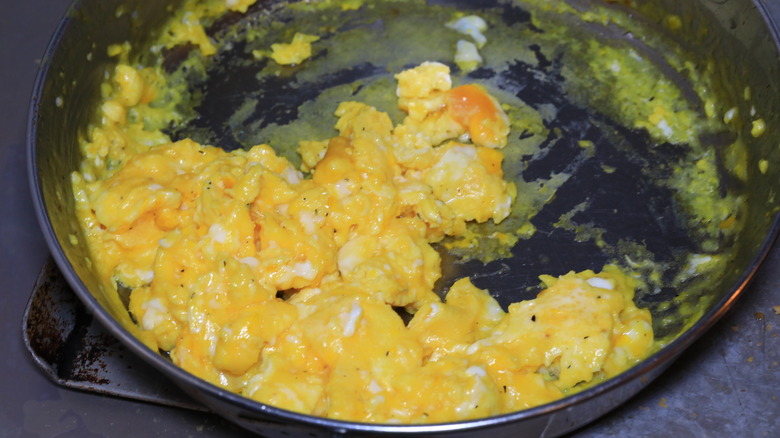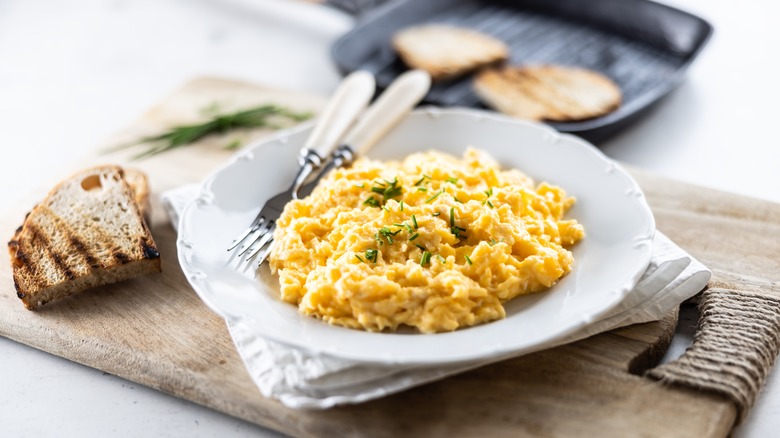10 Big Mistakes Experts Say Are Ruining Your Scrambled Eggs
Believe it or not, eggs are one of the hardest foods to get right in the kitchen. From common mistakes you're probably making when poaching eggs to fried egg fails, there's a lot to learn when preparing this seemingly simple ingredient. Scrambled eggs are no different and, if properly prepared, can make for an incredible breakfast, a tasty brunch, or a brilliant light lunch option. If you've ever eaten restaurant-perfect scrambled eggs, you've probably wondered what exactly professional chefs do to get creamy, fluffy results every time.
To unravel the secrets of scrambled egg prep, we spoke to five chefs and culinary experts with plenty of egg-cellent (sorry) tips. Between them, they break down some of the most common mistakes people often make when cooking scrambled eggs and explain how to avoid these slip-ups in the future. Whether it's finding the right type of cookware or mastering timings and temperatures, these hacks will help you pull off breakfast like a pro.
1. Using poor quality or old eggs
Sarah Beth Tanner, professional eggspert at Pete & Gerry's, notes that egg quality is super important when making a scramble. She states that "The biggest mistake of all is choosing low-quality eggs [...] Flavor starts in the shell, and eggs from free-range and pasture-raised hens [...] are much more flavorful [and have] creamy, golden yolks." Pasture-raised and free-range eggs are also slightly more nutrient-dense than cage-reared eggs, making them a great source of vitamin A, magnesium, and omega-3 fats.
While slightly older eggs might be one of the absolute best boiled egg hacks for easy peeling, using fresh eggs for a scramble will generally give you the best flavor and consistency. As eggs age, the whites become increasingly loose and thin, meaning that your scrambled eggs could end up with a watery texture. To get the curd-like, creamy bind associated with really great scrambled eggs, you need fresh eggs with thick whites that will easily clump together.
2. Cracking your eggs under pressure
Most people don't give much thought to how they crack their eggs. So long as the eggs end up in the pan, it's no big deal, right? Well, according to Kevin Ashton, Culinary Advisor at Restaurantji, you should avoid putting inward pressure on your egg's shell when you break into it. Ashton notes, "When you crack your eggs over the sharp edge of a table or bowl, this method [...] pushes shell into the egg, producing small shards that wind up in the scramble."
This also goes for cracking your eggs with a butter knife, which forces pressure inwards. Instead, Ashton recommends cracking your eggs on a flat surface. Be careful not to slam them down hard, which could cause the egg to shatter completely. A few taps on a hard sideboard should be enough to lightly crack your egg so you can drop it into a bowl or pan. The other safe method Ashton recommends is to "hold the egg in your palm and gently tap it with the back of a tablespoon."
3. Not whisking your eggs beforehand
While Martha Stewart's key to fluffy scrambled eggs might be a common coffee gadget, many of us like to keep our egg prep pretty simple. One important step that you shouldn't skip, however, is whisking your eggs before cooking. Chef Serge Krikorian, founder of Vibrant Occasions Catering, explains that "whisking is key because it incorporates air, making the eggs light and fluffy." To do this, you can simply break your eggs into a bowl and mix them with a fork for around 30-60 seconds.
However, while aerating your eggs is important, it's also possible to over whisk your mixture and accidentally ruin your scrambled eggs this way. According to Sarah Beth Tanner, "eggs are high in protein [so] the more you work the protein, the tougher it gets." This means that your egg scramble may end up chewy or rubbery if you overbeat them before cooking. To avoid this, Serge Krikorian recommends whisking your eggs until you see small bubbles start to form and then pour them into your pan.
4. Adding extra liquid to your eggs
Adding some milk, creme fraiche, or sour cream is one of the best ways to elevate your everyday scrambled eggs and give them a luxe, silky quality. However, Kevin Ashton notes that timing is very important when incorporating extra dairy into your scrambled eggs. According to Ashton, "Many people think that adding water, cream, or milk to the eggs will keep them creamy while cooking, but the opposite is true. The egg and liquid will separate during cooking, creating a layer of wet and overcooked eggs."
To avoid this problem, and still enjoy an indulgent, cream-laced scramble, Ashton suggests adding your dairy ingredients right at the end, once your eggs are almost cooked or right after you have taken the pan off the heat. You can also make cheesy scrambled eggs by sprinkling grated cheese into your pan — again, it's best to wait until the eggs have started cooking and then fold the cheese in to help it melt.
5. Not seasoning your eggs at the right time
When it comes to seasoning, scrambled eggs can be as simple or as complex as you like. Whether you love a plain old sprinkle of salt and pepper or you like to add some heat with sriracha or hot sauce, eggs take seasoning exceptionally well and can be a highly flavorsome snack. Professional pastry chef and food writer for The Skillful Cook, Amy Hand, encourages people to season their scrambled eggs but notes that you must add your flavorings at the right time.
She explains that while "many foods only require seasoning at the end [...], this is not the case with eggs [because], once cooked, it's harder to get the eggs to absorb seasoning evenly." This means that, if you add a pinch of salt to your cooked scrambled eggs, you might end up with extra salty clumps where the salt lands and a bland flavor throughout the rest of the dish.
According to Hand, the best time to add seasoning to your eggs is right after you've done your whisking and just before you put them on the heat. Stir your eggs to a light, bubbly foam, then add your seasonings and give it a final quick mix. In addition to salt and pepper, you can also season your eggs with dried herbs, such as thyme, parsley, or dill.
6. Using the wrong type of cookware
There's no getting around the fact that scrambled egg residue can be tricky to scrub off the bottom of a pan, but using the wrong type of pan can make this a lot worse. Kevin Ashton notes that you should "avoid a cast-iron skillet because its textured surface will snag more, causing more egg debris left on the pan and fewer eggs on your plate." Instead, he recommends using a stainless-steel pan with plenty of butter or oil to help keep the eggs mobile while you stir or a non-stick pan. Some older non-stick pans are coated with carcinogenic coatings, such as PFOAs and PFOs, so it's best to choose a more modern non-stick pan wherever possible.
Non-stick aluminum cookware is also a good option for making scrambled eggs. If you accidentally burn your eggs or you're still left with bits on the pan base, you can solve the problem using baking powder or vinegar. These pantry staples clean aluminum pans easily and are things most people have in their cupboards at home.
7. Stirring your eggs too soon
Everybody knows you need to stir scrambled eggs, and it can be tempting to get started as soon as they hit the pan. However, according to Christina Ferrari, chef and owner at Shoreline Lake Boathouse & American Bistro, you want to "avoid deflating the mixture while cooking. Be patient enough to let the eggs set up initially, and then use a silicone spatula to start gently pulling the eggs from the outer edge to the center in a folding pattern." This will allow slightly larger curds to form, which you can then break down into smaller lumps.
If you start to stir your eggs immediately, it may make it harder for curds to form, leading to thin scrambled eggs that don't look as aesthetic served on toast or heaped on a crispy bagel. While you need to move your eggs frequently throughout the cooking process, try not to overbeat them. Instead, you should aim to pile the curds loosely on top of each other while heating so that they cook evenly.
8. Keeping the heat too high
One of the best expert-approved tips for the fluffiest scrambled eggs is to control the heat while cooking. Kevin Ashton notes, "It's easy to burn your eggs if the pan is too hot [...] Instead of turning your heat to high, keep it at medium-low to ensure your eggs are not overcooked." Preparing eggs is a delicate process because eggs cook quickly and may scorch and stick to the pan if the heat is high. Keeping the heat low gives you more control over how fast and evenly the eggs cook, giving you time to stir them around and ensure that all parts of the scramble are exposed to the pan base.
Eggs that cook too fast on high heat tend to have a bouncy or rubbery consistency and can take on a slightly burnt flavor. Ashton recommends dropping your eggs into the pan just before your butter has fully dissolved, as this is a good indicator that the pan is warm but not too hot. Once the butter has begun to sizzle and hiss, your pan is too hot, and your eggs may start to cook too quickly as you pour them in.
9. Overcooking your eggs
In addition to being mindful about your eggs while they are on the heat, you also need to remember that food continues to cook from residual heat even after it's removed from the hob. This means that, even if you've cooked your scrambled eggs perfectly in the pan, they could start to turn dry or overcook while being transferred to your plate. To avoid this, Christina Ferrari explains that "the eggs should be removed from the heat at the final stages of cooking (when they appear a little wet), and a splash of cream or a cube of butter [should] be added to stop the cooking."
Judging this can take a bit of practice and comes down, in part, to how moist you like your scrambled eggs. In general, it is a good idea to take them off the heat when they are just slightly wetter than your preferred consistency as, by the time they get to your plate, they should be just right.
10. Serving your eggs on a cold plate
Serving hot food on a cold plate is a common culinary faux pas that we're probably all guilty of, especially when you're just cooking for yourself or when you're pushed for time. However, if you're trying to make the best scrambled eggs you can or want to impress friends and family with your chef's skills, warming your plate will make a big difference.
As Kevin Ashton concludes, you don't want to "go through all the hard work of mixing, cooking, and flavoring your eggs only to serve them on a cold plate. It will ruin everything. Temperature can alter how we perceive food, and a cold plate of scrambled eggs isn't appetizing."
To heat your plates while making scrambled eggs, turn your oven on low and leave the plates inside while you cook. You could also give your plates a few seconds in the microwave until they are warm, or run them under hot water and then dry thoroughly before use.
